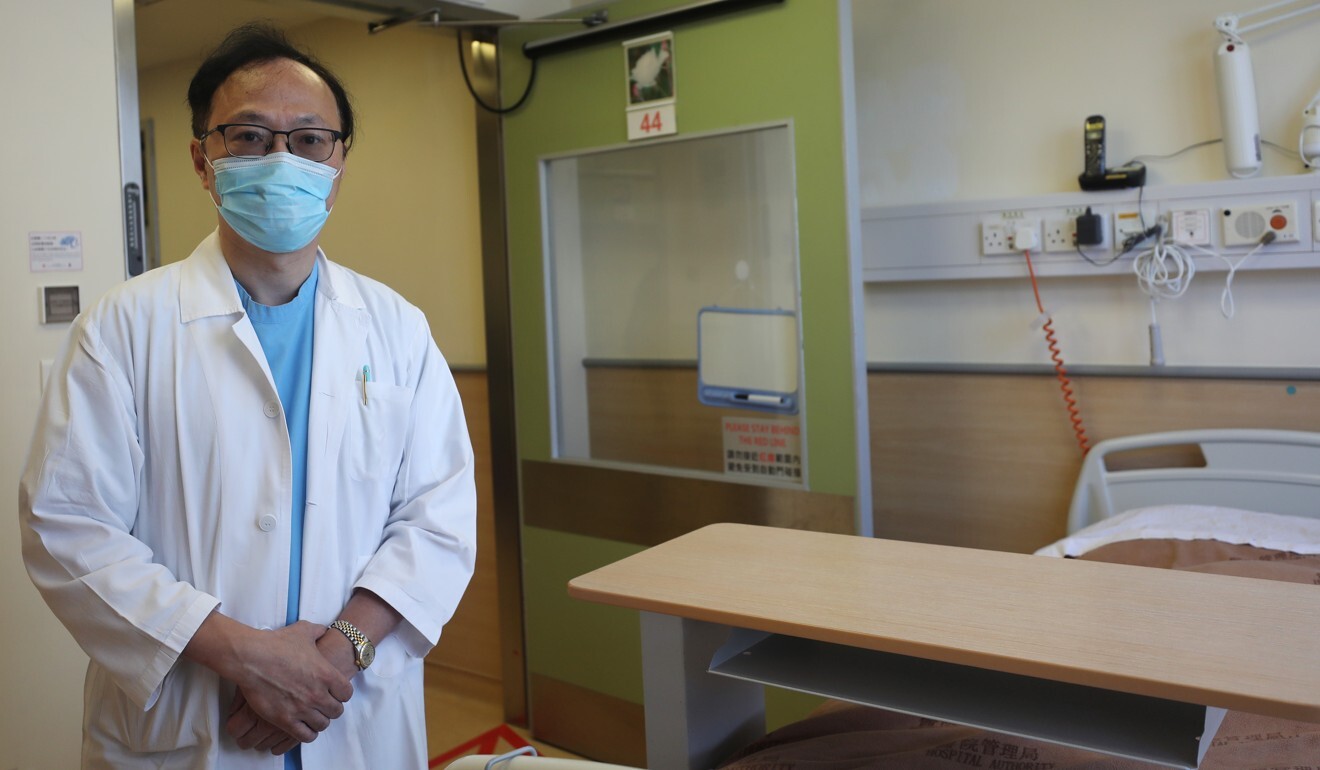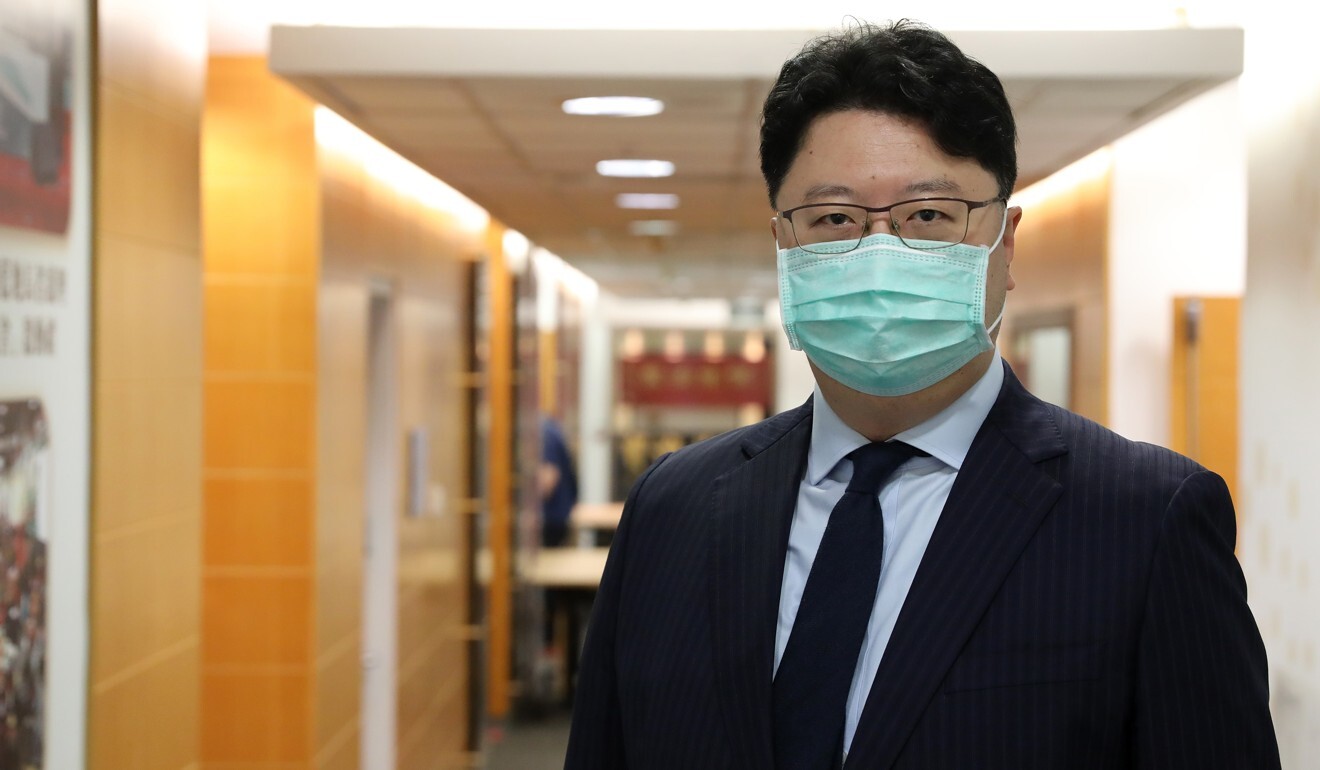
No sleep, no family time: Hong Kong’s medical heroes recall deepest fears caring for coronavirus patients
- Doctor who received first of patients from city’s hotpot cluster relives horror of facing the possibility that city was on the cusp of a major outbreak
- He recounts how he had to save time and reduce risks by staying in a hotel, away from family, and how a younger colleague was reduced to tears
When Dr Raymond Liu Wai-to received five Covid-19 patients from the same family one night in February, he feared what might come next.
“I thought Hong Kong could be on the cusp of a large community outbreak, which would overwhelm the public health care system and have disastrous consequences,” said the infectious disease specialist and chief of Ruttonjee Hospital’s isolation ward.
His anxiety deepened when the father in the family of patients became so ill he was coughing blood. This was even before his positive result for the coronavirus had been confirmed.
Liu knew he had to make a call.
“His symptoms were in line with that of a coronavirus infection. So I decided to wait no more and gave him a cocktail therapy of drugs.”
The strategy worked and the man’s respiratory symptoms subsided. The five patients would later be known as part of the hotpot cluster, the first local outbreak involving 13 people linked to a dinner gathering in Kwun Tong.
Thankfully, Liu’s deepest fears have yet to be realised, as Hong Kong marked the 100th day of its coronavirus battle on Friday with new cases dwindling, suggesting there was light at the end of tunnel.
The city has weathered successive waves of imported infections from mainland China, the Diamond Princess cruise ship in Japan, Europe and the United States; as well as several local outbreaks, most notably the bar cluster of 103 cases, the Buddhist worship hall cluster with 19, and a group of 15 linked to a wedding party on Lantau Island.

Affectionately known to colleagues as the “old general” who has steered the hospital through the treacherous waters of the severe acute respiratory syndrome (Sars) and swine flu outbreaks, Liu, a senior medical officer in the department of medicine and geriatrics, put his hand up early in January to lead the medical team in the isolation ward for Covid-19 patients.
Musician from Hong Kong’s Covid-19 bar cluster recounts harrowing experience
For the next 1½ months, Liu slept only two to three hours on average a day, and toiled to supervise every aspect of the medical effort, from receiving and screening patients, to their diagnosis and treatment. To save precious time and avoid passing the virus to his family, Liu stayed in a hotel that was a 10-minute walk from his work.
“I have not gone back home and seen my family since the beginning of this pandemic,” the father of one said.

About 20 colleagues quickly joined Liu’s squad, but some were intensely worried about infection risks. “One younger colleague felt very anxious and cried,” Liu said. “Twenty per cent of those who died during Sars in Hong Kong were medical staff, and some even wore personal protective equipment. In the absence of other information about the coronavirus, this figure was the reference point and was of course worrying.”
To inspire confidence, Liu took a hands-on approach and emphasised team work. “We would watch each other putting on and taking off our gowns even when we were not going in, just to make sure we completed every step and as a way to cheer each other on,” he said.
Hong Kong raised its response to Covid-19 to the serious level, the second-highest tier on its crisis system, on January 4. The Hospital Authority’s infectious disease centre at Princess Margaret Hospital in Kwai Chung, which was set up in 2007 in the wake of Sars, was quickly put on standby and took in the city’s first 20 Covid-19 patients.
Looking back, Owen Tsang Tak-yin, the centre’s medical director, revealed that his early anxieties involved finding suitable drugs for the disease. “Our biggest worry was whether we would know very quickly which drugs could help defeat the virus,” he said.
Pandemic exposes Hong Kong’s inadequate links between public, private hospitals
The authority hammered out the treatment plan on February 6, using a cocktail therapy of Kaletra, a drug originally for HIV and Aids; Ribavirin, which was also used for hepatitis C; and interferon; and later adding Remdesivir to the mix.
Tsang has studied the clinical characteristics of Covid-19 patients. He said many of those discharged still had a long road to a full recovery. Of the 20 patients who have gone back to the hospital for a check-up, more than half retained only 80 per cent of their pre-infection lung diffusion capacity.
The lung function is a crucial measure of how well oxygen and carbon dioxide are transferred between the organ and the blood, and Tsang said two patients with a smoking background and underlying illnesses had their diffusion capacity vastly reduced to just 50 and 30 per cent of their original state.
“It would be fine if the person is just sitting down, but he will experience difficulties if he is walking up the stairs,” he said.

Nine discharged patients in Hong Kong have tested positive for the virus again in a PCR antigen test that detects the sequence of the virus RNA, but Tsang said he was not worried about their susceptibility to infection.
Citing a recent study in Germany published in the science journal Nature, Tsang said the findings showed the virus in the respiratory and stool samples of nine Covid-19 patients could not be cultured eight days from onset, even if their PCR test results were still positive, meaning the virus in their bodies was not infectious.
Tsang believed the current discharge criteria demanding that patients record two consecutive negative PCR test results taken 24 hours apart was “very safe” because it was “very hard” to return negative readings.
Lessons of pandemic have officials ‘rethinking plans’ for Hong Kong’s public hospitals
“But if unfortunately there is a big spike in patients one day, we can put some with a low viral load in some isolation facilities in the community,” he said, adding those with a viral load of fewer than 100,000 copies per millilitre after 10 days from their onset dates could be considered safe.
Some recovered patients have donated their convalescent plasma containing antibodies to the virus which Tsang said was ready for use and would be reserved for seriously ill patients at an early stage of the disease.
Covid-19 is a sly enemy. Most of the time it gives you light punches in the boxing ring, as many patients are asymptomatic
Last month, a 93-year-old man was reported as possibly infected with Covid-19 during his stay in Pok Oi Hospital in Yuen Long in early April, raising the spectre of Sars when medical staff and patients were cross-infected at Prince of Wales Hospital in Sha Tin.
Pok Oi’s chief executive Dr Chong Yee-hung said his biggest worry at that time was how the patient, who was mostly in hospital during the virus incubation period, got infected. “Were there any unknown sources inside the hospital?” Chong said.

The hospital eventually tested more than 100 patients and 300 of its staff, and all returned negative results. The two medical and geriatric wards where the infected man stayed were closed for about three weeks for disinfection. Environmental samples collected in the hospital also came back negative.
The hospital later said the elderly man was suspected to be infected after he shared medical devices, such as a blood pressure monitor, with a 33-year-old patient later confirmed as having the coronavirus.
Transmission might also have occurred when health care workers in contact with the younger patient failed to clean their hands properly before handling the older man.
With the health scare now behind him, Chong said this was a “small episode” in a long fight against the disease in Hong Kong.
Dr Raymond Liu agreed the battle was not over. “Covid-19 is a sly enemy. Most of the time it gives you light punches in the boxing ring, as many patients are asymptomatic.
“But once in a while, like Mike Tyson, one punch is enough to wipe you out.”
Additional reporting by Elizabeth Cheung
This is the last of a four-part series on 100 days of Hong Kong’s battle with Covid-19. Other parts of this series have examined how the pandemic exposed Hong Kong’s inadequate links between public and private hospitals; how the virus has officials rethinking plans for Hong Kong’s public hospitals; and, the harrowing account of a musician who was part of Hong Kong’s Covid-19 bar cluster.
Help us understand what you are interested in so that we can improve SCMP and provide a better experience for you. We would like to invite you to take this five-minute survey on how you engage with SCMP and the news.





